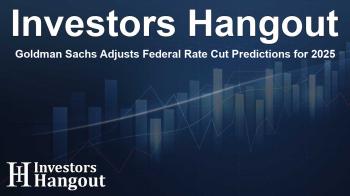Goldman Sachs Adjusts Federal Rate Cut Predictions for 2025

Goldman Sachs Adjusts Its Rate Cut Forecast
Goldman Sachs analysts have recently updated their outlook regarding the Federal Reserve's interest rate cuts, now anticipating only two cuts this year, a reduction from their earlier expectation of three. This shift stems from growing concerns over persistent inflation and a resilient labor market that complicate the economic landscape.
Future Rate Cut Predictions
Looking ahead, Goldman Sachs foresees two additional rate cuts in 2025, specifically in June and December, alongside one more anticipated cut in 2026. This adjustment would lower the Fed's terminal rate to a range of 3.5% to 3.75%, down from current levels of 4.25% to 4.5%. The revised estimates reflect a more cautious approach towards monetary policy.
Impact of Strong Labor Market Data
The adjustment in Goldman Sachs' expectations was closely tied to stronger-than-expected employment data. Recent reports showed growth in nonfarm payrolls, which contributed to market speculation that the Federal Reserve may not feel the need to aggressively reduce interest rates. This data has led to notable fluctuations in Wall Street as analysts reassess their predictions.
Shifts in Monetary Policy Outlook
The Federal Reserve had previously anticipated more rapid cuts, projecting a reduction of its rate by 1% through 2024. However, their updated outlook now suggests a significantly slower pace of cuts, decreasing from four to only two projected reductions by 2025. This change reflects heightened worries regarding ongoing inflationary pressures and the stability of the labor market, indicating that the economic conditions may necessitate a more measured approach.
The Complexity of Future Economic Data
Though Goldman Sachs maintains a baseline forecast that leans towards a dovish stance compared to market expectations, they emphasize the uncertainty surrounding the timing of future cuts. The confluence of forthcoming robust U.S. economic data adds complexity to the decision-making process, making it difficult to predict exactly when these adjustments will occur.
Considerations Under New Leadership
As the U.S. prepares for new leadership with President Donald Trump, analysts from Goldman Sachs are contemplating how increased trade tariffs may influence monetary policy. Trump has signaled intentions to impose significant tariffs on key trading partners, particularly China, which could have far-reaching implications for import costs and domestic pricing.
Potential Effects of Tariffs on Inflation
Despite the potential for higher tariffs, Goldman Sachs analysts do not foresee a major influence from Trump's fiscal or immigration policies on inflation levels. Their assessment suggests that even with the implementation of tariffs, the likelihood of inflation reaching levels that trigger interest rate hikes or destabilize Wall Street remains low.
Conclusion
The evolving economic landscape continues to challenge financial analysts, particularly with the unpredictable elements introduced by fiscal policy changes and trade considerations. Goldman Sachs' revised forecast regarding Federal Reserve interest rate cuts reflects cautious optimism and highlights the complexities of current market dynamics.
Frequently Asked Questions
What is Goldman Sachs' new prediction for Fed rate cuts?
Goldman Sachs now predicts that the Federal Reserve will implement two interest rate cuts this year, contrary to their earlier forecast of three.
When do analysts expect future rate cuts?
They anticipate additional cuts in mid-2025, specifically in June and December, with a further reduction planned for 2026.
What factors influenced Goldman Sachs' revised forecast?
Stronger-than-expected employment data and concerns over inflation and the labor market played critical roles in this revision.
How might new trade tariffs affect the economy?
The imposition of new trade tariffs could influence import costs but is not expected to significantly drive inflation or necessitate immediate rate hikes.
What are the potential ramifications of this forecast on Wall Street?
The forecasting shift could contribute to market fluctuations as investors reassess their strategies based on the anticipated slower pace of rate cuts and external economic influences.
About Investors Hangout
Investors Hangout is a leading online stock forum for financial discussion and learning, offering a wide range of free tools and resources. It draws in traders of all levels, who exchange market knowledge, investigate trading tactics, and keep an eye on industry developments in real time. Featuring financial articles, stock message boards, quotes, charts, company profiles, and live news updates. Through cooperative learning and a wealth of informational resources, it helps users from novices creating their first portfolios to experts honing their techniques. Join Investors Hangout today: https://investorshangout.com/
Disclaimer: The content of this article is solely for general informational purposes only; it does not represent legal, financial, or investment advice. Investors Hangout does not offer financial advice; the author is not a licensed financial advisor. Consult a qualified advisor before making any financial or investment decisions based on this article. The author's interpretation of publicly available data shapes the opinions presented here; as a result, they should not be taken as advice to purchase, sell, or hold any securities mentioned or any other investments. The author does not guarantee the accuracy, completeness, or timeliness of any material, providing it "as is." Information and market conditions may change; past performance is not indicative of future outcomes. If any of the material offered here is inaccurate, please contact us for corrections.
